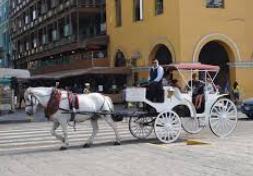The first thing we are going to do before entering fully into the definition of the term carriage is to know its etymological origin. In this case we can determine that it is a word that derives from the Provençal “cariatge”, which was used to refer to a vehicle mounted on wheels and equipped with an iron or metal frame.
Of course, that Provençal term comes, in turn, from Latin. Exactly from “carrus”, which can be translated as “vehicle with wheels”.
A carriage is a vehicle that has an iron or wooden frame installed on wheels.
 From this meaning, it follows that there are many types of carriages. A carriage that has two wheels and poles that serve as a hitch for the team is called a cart . In carts, their frame is a frame with ropes to support the load.
From this meaning, it follows that there are many types of carriages. A carriage that has two wheels and poles that serve as a hitch for the team is called a cart . In carts, their frame is a frame with ropes to support the load.
Carriages with four wheels that are pulled by animals and have a box with a seat for at least two people are called cars . If the car is very wide, has prominent ornamentation and is drawn by horses, it is called a carriage .
In ancient times, carriages were a widely used means of transportation. Currently, however, these are collector 's items that are only used within the framework of certain ceremonies or as a tourist attraction.
Elm , ash , black poplar and oak are some of the woods most used in the construction of carriages. This wooden structure is linked to elastic springs that serve as suspension.
As for the wheels of the carriages, they have a piece (the hub ) from which the spokes come out, which enter a circumference formed by the pinas . This circumference is reinforced with a hoop (the rim ).
In addition to everything stated above, it is worth knowing other particularities about the carriage, among which we can highlight the following:
-It is considered that its invention is between the 15th and 16th centuries.
-The first known carriage in the Iberian Peninsula dates from the year 1546, although other theories determine that the first was the one that Charles V's servant, Carlos Pubest, brought with him in the year 1554.
-During history the carriage has been used, among other things, as a messaging system vehicle. Thus, it is established that in the 19th century, specifically in the year 1825, a service of this type was launched in Paris that responded to the name of Omnibus.
-In Seville there is one of the best exhibition centers on this type of vehicles that concern us. We are referring to the Carriage Museum, which was launched in 1999 and has a wide variety of carriages such as the gala coupe models or the mail coach, among many others.
“El carruaje” , on the other hand, was the title of a forty-four-episode soap opera that aired on Mexican TV during 1972 . Set in 19th century Mexico , “The Carriage” featured performances by José Carlos Ruiz , María Elena Marqués and Carlos Monden .
